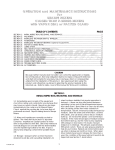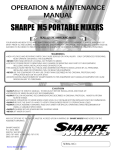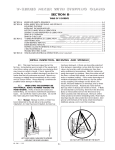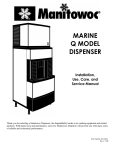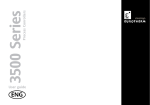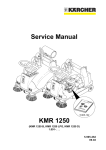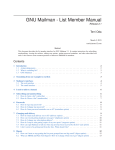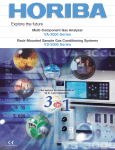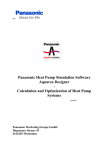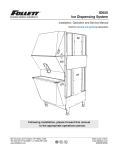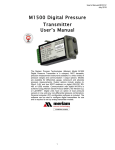Download F-SERIES MECH SEAL 1/04
Transcript
OPERATION and MAINTENANCE INSTRUCTIONS for SHARPE MIXERS CLOSED TANK F-SERIES MIXERS with MECHANICAL SEALS TABLE OF CONTENTS SECTION 1: SECTION 2: SECTION 3: SECTION 4: SECTION 5: SECTION 6: SECTION 7: SECTION 8: SECTION 9: SECTION 10: SECTION 11: SECTION 12: SECTION 13: SECTION 14: SECTION 15: SECTION 16: SECTION 17: PAGE INITIAL INSPECTION, RECEIVING, AND STORAGE........................................ 1 MOUNTING..................................................................................................... 2 INSTALLING THE MIXER SHAFT & IMPELLER...................................................2 POSITIONING.................................................................................................. 2 INSTALLING THE STEADY BEARING (optional equipment)..........................3 MOTOR CONNECTIONS.................................................................................4 LUBRICATION.................................................................................................. 4 MECHANICAL SEAL PREPARATION...............................................................5 MECHANICAL SEAL LUBRICATION................................................................ 6 OPERATION & START-UP CHECKLIST............................................................. 7 SIDE ENTRY RETRACTION................................................................................9 MECHANICAL SEAL REPLACEMENT.............................................................. 10 DIRECT DRIVE DISASSEMBLY.......................................................................... 11 GEAR DRIVE DISASSEMBLY............................................................................ 14 MIXER OFFSET GUIDE......................................................................................15 TROUBLE SHOOTING GUIDE...........................................................................16 ACCESSORIES................................................................................................. 18 CAUTION Because neither manufacturer nor seller can control the application or installation of this product, their only obligation shall be to replace this part if defective and shall not be liable for any injury, loss, or damage, direct or consequential, arising from the installation of this product. User assumes all risk in using this product and is therefore cautioned in selecting the product suitable to the intended use. Refer to inside cover of this manual for Terms and Conditions. SECTION 1 INITIAL INSPECTION, RECEIVING AND STORAGE 1.1 Immediately upon receipt of the equipment check the crating and contents for any damage that may have occurred in transit. Report any damage immediately to the carrier and to Sharpe Mixers. Check against the packing slip to be sure that all parts were received. Report missing items to Sharpe Mixers. mixer has been installed, but regular operation is delayed, c) there are long idle periods between operating cycles, and d) plant/department operation is shut down. Store mixer in a clean dry location, with circulating air free from wide variations in temperature. Electric motors are easily damaged by moisture. Store the entire unit off the floor, covered with plastic, and use desiccants to reduce moisture build-up. Do not seal the plastic cover as this traps moisture. If the motor shows signs of moisture absorption before start-up, dry the motor out by applying 10% voltage on two leads ( if in doubt, measure resistance in windings). This will give approximately 50% rated current. There are also sprays available to help dry out motors. Relubricate motor before startup when in storage six months or more. When gear drive models have been in storage for more than a year, the condition of the gear lubricant needs to be inspected (see Section 7, Lubrication). 1.2 Mixer and impellers are normally packed together. The mixer shaft is packed in a separate container. Impellers are usually banded to mixer drive or lag-bolted to drive skid. Side entry mixers are normally shipped on one skid with the shaft installed and the impeller lag-bolted to the skid. If space allows, keep shipping containers for possible future use. 1.3 Storage: storage is when a) mixer has been deivered to job site and is awaiting installation, b) FMSSM 7/04 1 SECTION 2 MOUNTING 2.1 Flange mount: Standard 150 # flanges are provided. Refer to the Data Sheet in the front of this manual for the specific size supplied. A gasket needs to be installed between the tank nozzle and the mixer flange to stop leakage of tank contents and keep tank pressurized. Using lock washers or double nutting the mounting bolts is recommended to prevent bolts from loosening by equipment vibration. Mounting to an unstable support may cause unacceptable mixing, damage to the equipment, tank, or other hazards. 2.3 Side Entry Flange mount: Tie rods are normally provided with side entry mixers. The tie rods need to be positioned approximately 45° above horizontal and 45° from the mixer shaft centerline. These aid in the support of the mixer and need to be attached securely (see paragraph 2.2 for mounting strength requirements). If pipe legs are supplied, see specific mixer outline drawing else where in this manual for pipe leg size required. 2.2 Mounting structure must be stable and strong enough to hold the full mixer weight, torque, and overhung moment. Please contact Sharpe Mixers for these values if they are not listed on the outline drawing in the front of the manual. SECTION 3 INSTALLING THE MIXER SHAFT & IMPELLER (refer to pages 12 or 13) 3.1.2 For all other mechanical seals, install shaft through flange or ferrule. Use a light oil to aid in installation of seal. Slide seal parts onto shaft in order according to the drawings in front of manual and any seal instructions at end of manual. WARNING: Always lockout power before installing or removing mixer shaft or impeller. 3.1 The mixer shaft will have one end (marked: motor end) ground to fit the drive bearing and coupling. Slide the impeller(s) onto the opposite end with the concave side of the blades facing AWAY from motor end of shaft. A single impeller is best mounted at the end of the shaft or 1-2 prop diameters above tank bottom. The upper impeller (if supplied) is normally mounted a minimum of 2 impeller diameters below the liquid surface. Tighten the set screws securely. High horsepower units will have “divots” into which the set screws should be tightened. FOR SIDE ENTRY MIXERS, skip paragraph 3.2 as the mixer shaft is installed at the factory. 3.2 Remove the service window 512 from the mixer spool so the bearing and coupling are visible (see page 12 or 13). Rotate the coupling until the two coupling bolts 651 are accessible. Install the mixer shaft (with the end marked motor end) up through the lip seal, 360 bearing, 301 , and into the drive coupling 650 . Be sure of full engagement of the shaft into the split coupling. DO NOT use oil to aid in assembly or slippage may occur. Using the 3/16" hex wrench supplied, TIGHTEN THE TWO BOLTS IN THE COUPLING 651 , gripping the mixer shaft in position. Tighten SECURELY as these bolts transmit the mixer torque. TIGHTEN THE TWO BEARING SET SCREWS 310 , using the 1/8" hex wrench provided. Fasten seal setscrews and bolts. 3.1.1 For split mechanical seals, follow instructions in sec 3.2 and bolt seal in place after shaft installation. See end of manual for any special instructions. SECTION 4 POSITIONING 4.1 The following drawings are for reference only. If there is any question concerning the proper position of your F-series mixer, please contact your Sharpe Mixers representative or the factory as your specific application may be different than recommendations shown. R A 2D D >1.5D C D 4.2 If tank diameter is approximately equal to liquid depth, use 1 prop, placed at least 2 prop diameters from the bottom of the tank. 4.3 See drawing A2787 in section 15 for angular offset mounting dimensions. Consult factory for special applications, including square/rectangular tanks. 2 4.4 If tank height is greater than 1.5x the diameter, use 2 props. Position lower prop at least 2 prop diameters from bottom. Place upper prop halfway between bottom and top of liquid level. FMSSM 7/04 4.5 For drawing down light powders, position mixer in center of tank to create a vortex. A vortex may not be recommended for some products. Depth of prop will vary vortex. 4.6 Baffles may be used to prevent vortexing when mixer is mounted on center. Baffling may not be required with more viscous products or square/rectangular tanks. SECTION 5 INSTALLING THE STEADY BEARING (optional equipment) 5.1 This section is for those mixers which include the optional steady bearing to accommodate longer than standard mixer shafts. A steady bearing must be installed only after the drive assembly and lower mixer shaft have been assembled and firmly bolted in place. DO NOT predetermine the exact bearing location from tank and mixer outline dimension drawings. The vertical center line of the steady bearing must coincide with the shaft's axis of rotation to minimize bearing preload (see Figure 5.1). This axis may not necessarily be at the center of the tank. The mixer shaft must be hand rotated (using input shaft coupling or motor fan) with a fixture attached to the shaft to mark a line on the tank bottom. NEVER APPLY POWER WITHOUT STEADY BEARING INSTALLED. The center of this inscribed area will be the location for the center of the steady bearing. 5.2 The steady bearing must be securely installed, with its vertical centerline coincident with the axis of rotation, as established. The amount of lateral movement required to bring the shaft into proper alignment with the final steady bearing location will vary, depending upon the shaft length and diameter. 5.3 The steady bearing is a wearing part and should be checked periodically for wear. Path of shaft when rotated by hand Bow in shaft greatly exaggerated for clarity Shaft axis and final location of centerline of steady bearing for proper rotation Shaft axis FIGURE 5.1 FMSSM 7/04 3 SECTION 6 MOTOR CONNECTIONS Rotation of the propeller must be clockwise looking down. Interchange lines if necessary for proper rotation. WARNING: High voltage and rotating parts can cause serious or fatal injury. Electric machinery can be hazardous. Installation, operation, and maintenance of electric machinery should be performed by qualified personnel. Familiarity with NEMA safety standards, National Electric Code and local building codes are required. 6.5 Electric Variable Speed: Electric motors using an SCR or variable frequency controller must be wired following the instructions supplied with the controller. Many adjustments are often required to the controller and instructions should be read carefully before applying power. Adjust the controller to limit the maximum speed to the motor nameplate R.P.M. ( or refer to the motor speed in the data sheet at the front of this manual ). 6.1 Wiring: Starting and overload contol devices must be matched to motor rating. Follow control manufacturer's instructions for proper connections and installation. 6.2 Electrical connections must conform to National Electrical code and all local regulations. Line voltage and wire capacity must match motor rating stamped on motor nameplate. 6.6 Air motors: Air driven mixers must always have a filter, lubricator and moisture trap installed in the air line ahead of the motor to prevent damage. Use the same size or next size pipe size larger than intake port of motor. A regulator can be used to govern the mixer speed. Install the air line in the proper port to provide clockwise rotation of the propeller shaft when viewed from above. The muffler is always installed at the factory in its proper position. 6.3 Electric motors - single phase: If your mixer is supplied with a single phase motor it may be wired by the factory with a ten foot cord and an on/off switch. If no cord or switch is provided refer to the wiring diagram on the motor for correct connections. Check that the switch is in the off position before plugging the cord into a 110 volt outlet. Check rotation! WARNING: Damage to equipment or serious injury to personnel can result if speed limitations are not followed. 6.4 Electric motors - 3 phase: Motors requiring 3 phase power should be wired according to the wiring diagrams on the motor. SECTION 7 LUBRICATION 6.1 Your mixer has been lubricated at the factory with the proper type and amount of lubrication for mixer service (gear drive units only). This lubricant needn’t be changed under normal conditions for a period of 3 years. Under extreme conditions it is recommended that the lubricant in the gear box be changed more frequently . Remove motor to repack gearbox. Refer to the chart below for the lubricant recommended for temperatures in your area. When changing to a different lubricant, clean gearbox with mineral spirits before repacking. SERVICE 32°F (0°C) and up LUBRICANT oil based EP Semi fluid grease CHEVRON EQUIVALENT Black Pearl NLGI 1 (standard from factory) Down to -20°F (-29°C) and up to 300°F (149°C) Synthetic EP ULTI-PLEX synthetic grease EP Food grade Food grade EP-2 Chevron FM grease EP2 6.3 Air motor lubrication: Lubricator needs to be adjusted to feed one drop of oil for every 50 - 75 CFM of air through the motor. Use a detergent SAE #10 automotive engine oil. 6.2 Electric motor bearings are usually sealed and need no relubrication. If zirc fittings are present relubricate with a No. 2 consistency lithium soap base and petroleum compound (every 6 months to 3 years depending on usage). Open and clean drains. Add grease until new grease is forced out drain. Remove excess grease and replace input plugs. Run motor one half hour before replaceing drain plugs. Mixer shaft bearings are sealed and need no relubrication. 4 FMSSM 7/04 SECTION 8 MECHANICAL SEAL PREPARATION 8.1 Mechanical seals are precision machined, fragile components that are easily damaged by careless handling. Any servicing of mechanical seal must be handled in a clean “white coat” manner. Even a fingerprint on the mating seal faces can cause premature leakage. Most premature seal failures are due to lack of lubrication or improper installation. Seal manufacturers offer mechanical seal maintenance seminars or seal schools to help service personnel understand seal operation better. The minimal cost and time required for this education is easily justified when you consider the expense down time and loss of product which occurs when mechanical seals fail prematurely. damage to equipment, and present difficulties for mechanical seals. In general, the cure involves flushes, purges, and temperature controls. See mechanical seal lubrication (Section 9) for more information on lubrication and flushing of mechanical seals. 8.2 Do not even allow the mixer to be wired before preparing the seal for operation. The electrician may “bump start” to check for rotation and ruin the seal in the process. Many double mechanical seals have assembly positioning tabs which hold the seal wear sleeve on center in position during shipping and assembly. These tabs must be rotated out of the way or removed completely before start-up. 8.6.2 PRECIPITATING LIQUIDS: Solids which precipitate out of a liquid do so by reason of either an increase in concentration, or because of a lowering (or in some cases a raising) of temperature beyond that at which it is proper to operate. Illustrations are caustic soda and calcium hydroxide. With ammonium nitrate, for example, temperature must be controlled at an optimum level in relation to its concentration. If the temperature rises above the optimum, it will boil and form crystals, and conversely if temperature drops, it will become saturated and salt out. 8.6.1 SUSPENDED SOLIDS: Solids which are suspended in liquids and which are an inherent part of their structure would include starch, contaminated or muddy water, sand, and other slurries. This is best handled by an external flush of clean liquid through a lantern ring. Flushing pressure needs to be 15 - 30 psi greater than tank pressure. 8.3 The mechanical seal housing or gland plate will have one or more tapped holes for lube/vent/drain, which will be plugged from the factory with a temporary plastic plug. These plugs must be replaced with the proper flush/lube/recirculating line or dead end plug as described below under MECHANICAL SEAL LUBRICATION (Section 9). 8.6.3 EVAPORATING LIQUIDS: Solids can form as a result of heat which promotes evaporation. Examples include any of the hot chemical salts - the chlorides, chlorates, sulfates, sulfides. Cool by flushing or by utilizing water jackets. 8.4 Tank liquid level must be filled to at least one prop diameter above the impeller elevation before starting mixer. Mixer must never run when liquid level drops below this point. A low liquid alarm or shut-off switch is recommended if low liquid levels are likely to occur. 8.6.4 CONGEALING LIQUIDS: Generally speaking, these liquids congeal either because of a drop in temperature, or as a result of drying out after exposure to air. Sugar syrups fall into both categories. A good rule is to keep the fluid moving before congealing can take place. Control with heat and/or by flush or purge. Clean liquid flush pressure needs to be 25 psi greater than tank pressure. (a) Asphalt is a typical case of a liquid which congeals as it cools, and this can be controlled by heat. Some sugar syrups fall under this category. Be sure to heat thoroughly before start-up, during operation, and after shutdown if followed by a purge. (b) Some products harden to a solid state when exposed to air. Glue, molasses, paint, sugars are examples. An effective flush is a dead end lubricator. This will keep out the air. Note that this type of flush does not enter the product, but only mixes with the product leakage. It may also be desirable to purge utilizing a solvent of the liquid being mixed. Periodically vent dead end lubricated seals to clean chamber. 8.5 Make sure all valves are open to insure the seal receives a positive flow of liquid at all times. Bleed all gases trapped in the seal cavity before start-up, or the cavity may vapor lock and the seal will burn-up running dry. On high speed (above 350 rpm) and high temperature applications the mechanical seal housing must be constantly flushed with a cooling lubricant before applying power to the mixer, or heat will quickly build and destroy the seal. Where colder ambient temperatures will cause thickening of the lubricant, the seal housing and lubricant lines must be preheated to allow free flowing lubricant to seal before start-up. Never allow the seal or lubrication lines to freeze. 8.6 SEALING ABRASIVE LIQUIDS: As used here “abrasives” is a broad term intended to cover the problem of sealing against slurries, congealing liquids, crystallizing salts and the like. They cause the greatest FMSSM 7/04 5 SECTION 9 MECHANICAL SEAL LUBRICATION 9.1 SEAL LUBRICATION is required at all times during operation of the mixing equipment. The only exception are “dry running” seals which are clearly stated in the seal description in the front of this manual. HEAT TO DEVELOP - BACK OFF GLAND NUTS IF IT DOES. As leakage levels off, tighten at 15 minute intervals until leakage is controlled without developing heat. 9.4 SINGLE EXTERNALLY MOUNTED SEAL: This design positions the rotating elements of the seal outboard from the tank contents and is lubricated by one of the following means: 9.2 Lubrication system designs are as varied as customers applications. Listed below are some typical application designs. Study the seal drawing and description in this manual and circle the lubrication system that best describes your application. Reservoirs, filters, rotameters, flow and pressure control valves and gauges as required, may be purchased from Sharpe Mixers. 9.4.1 Seal flushing - requires a line of lubricant (usually water) plumbed to the seal housing and a line from the seal housing to a drain. In this design, the seal housing will usually incorporate a lip seal to contain the lubricant in the housing, but will not hold pressure within the seal housing. Therefore, a flow restriction and pressure reducing valve must be incorporated in the supply line to the seal. An in-line filter is also recommended. Never allow pressure to build within the seal housing or you may blowout the lip seal. The drainage line must rise above the elevation of the seal housing by a few inches to guarantee seal will be lubricated without siphoning and must be free flowing to prevent pressure buildup. 9.3 SINGLE INTERNALLY MOUNTED SEAL: This design has the rotating elements of the seal in contact with the tank contents, and is lubricated by one of the following means: 9.3.1 Lubricant flushing - requires a line of compatible lubricant (usually water) plumbed to the housing at a higher pressure than the tank. This allows a constant flushing of cleansing lubricant through the seal housing and into the tank. It is recommended that a flow control valve, pressure gauge, and rotameter be installed in that order on the line to the seal. 9.4.2 Lubricated by tank contents (side entry only) this system requires the tank contents to have lubricating properties and to be clean of any solids. Any suspended solids or dissolved solids that may crystallize will build up in the seal housing and cause premature seal leakage. 9.3.2 Lubricated by tank contents - this system (for side entry only) requires the tank contents to have lubricating properties and to be clean of any solids. Any suspended solids or dissolved solids that may crystallize will build up in the seal housing and cause premature seal leakage. 9.5 DOUBLE MECHANICAL SEAL WITH THROUGH FLUSHING: This system requires a lubricant line plumbed to the seal (usually water) and another line from the seal housing to the drain. A flow control and pressure regulating valve needs to be placed on the drainage line from the seal to maintain a pressure in the seal housing 15-30 pounds higher than the tank pressure. A filter on the inlet to the seal is recommended. It is also recommended that a check valve on the inlet line be installed to prevent back flow of tank contents in case of loss of pressure in the flushing line. Pay special attention to seal housing temperature during operation. Never allow heat buildup in seal housing. Increase flow of flushing water to cool the seal. 9.3.3 The plugs in the seal housing need to be replaced by permanent stainless steel plugs (if not furnished). After filling tank, bleed all gases trapped in the seal housing or vapor lock may ruin the seal. If flushing is not used, periodic bleeding of the seal cavity will cleanse the solids buildup and extend seal life. 9.3.4 NOTE: Some smaller side entry mechanical seals have the seal mounted on the tank side of the mounting flange. This ensures abundant lubrication and flow to the seal faces, but exposed seal is very vulnerable and requires great care in handling. This seal design requires the mixer to be removed from the tank to replace the seal, but incorporates a secondary low pressure (packing style) backup seal to temporarily retain tank contents until mixer removal is convenient. The purpose of this packing is to control leakage, not prevent it. Packing must leak to perform properly, otherwise they will burn up. TFE packing is especially sensitive in this respect. DO NOT OVER TIGHTEN! Permit generous leakage. Gradually take up gland nuts 1/6 turn (1 flat in hex nuts) at a time. Watch temperature. NEVER PERMIT 9.6 DOUBLE MECHANICAL SEAL WITH NATURAL CONVECTION LUBRICANT RESERVOIR: This design requires a lubricant reservoir (usually 2-5 gallon capacity) mounted 6"-18" above, and no more than 3 ft. away from the mechanical seal. These systems are often furnished by Burhans-Sharpe, mounted on the agitator and fully plumbed to the seal housing. Lubricant circulation occurs when the lubricating fluid, heated by the seal, expands and becomes lighter and rises out of the seal to the top of the lubricant reservoir. Once in the reservoir the fluid cools becoming heavier and returns to the mechanical seal housing. Natural convection requires low restriction plumbing as follows: Use large diameter 6 FMSSM 7/04 tubing (1/2" recommended) from the upper most port in the seal housing to the upper liquid level in the lubricant reservoir. The return line runs from the bottom of the reservoir to the lower port in the seal housing. Keep horizontal runs to a minimum. 9.6.2 Many lubrication reservoirs incorporate “cooling coils” to further remove heat from the lubricating fluid on high temperature applications. Other lines may also be required to cool the seal housing or flange. These will be shown in the seal assembly drawing. Cooling water must circulate at all times when heat is present. 9.6.1 Fill the seal reservoir until liquid level is higher than upper most plumbing line. Recheck level after mixer has run a few minutes and replenish if necessary. Operating liquid must be thin (water like) since thicker materials will not flow, creating heat buildup and premature seal failure. If tank is pressurized, maintain 15 - 30 psi above tank pressure in the lubricant reservoir. This is accomplished by either a permanent air line to the top of the reservoir with a pressure regulating valve, a nitrogen tank or other compatible pressurized medium. A “back pressure” valve may be incorporated to prevent the back flow of tank contents in case of seal failure during a loss of pressure in the supply system. A low pressure shut off switch may also be used to shut down the mixer in case of a seal system failure. 9.6.3 A 10 weight oil (or other thin noncorrosive lubricating liquid) is recommended rather than water when the lubrication reservoir is carbon steel. 9.7 DOUBLE MECHANICAL SEAL WITH POSITIVE FLOW LUBRICATION SYSTEM: This system utilizes a remote lubricant reservoir with a pump supplying positive flow to and from the seal often with a cooling system, pressure and flow control valves, low level alarms and other integrated systems which require thorough study and preparation prior to start-up period. It is recommended that you contact the appropriate mechanical seal representative in your area for assistance with any questions you may have on the more intricate systems. SECTION 10 OPERATION 10.6 If impeller is buried in solids prior to starting mixer, solids must be dispersed. This may be achieved with an air hose, a recirculating pump, or a large stirring stick if necessary. 10.1 Rotate mixer shaft by hand to check shaft straightness to assure that the impeller is free of any obstructions in the tank. 10.2 Never operate mixer without the lower impeller immersed in the liquid by at least one prop diameter. Never operate mixer if fluid falls below this level. 10.7 Keep motors free from oil, dust, dirt, water, and chemicals. Keep air intakes and outlets free from foreign material. Electric motors supplied, although designed for outdoor use, may be damaged due to weather. A rain hood or other protection may be necessary to prolong motor life. Consult factory for recommendations. 10.3 Never operate mixer without the mechanical seal lubricated (see Sections 8 & 9). Dry running seals are the exception. 10.4 The propeller rotates clockwise when viewed from above. Opposite rotation may cause overload and inefficient mixing. 10.8 Check mixer drawing and Data Sheet for special operating requirements when using a variable speed drive or air motor when supplied by Burhans-Sharpe Co.. 10.5 Vortexing may occur if liquid level is too close to the upper impeller. This will cause aeration of the product and excessive vibration of the equipment. When mixing products of dissimilar viscosities and/or specific gravities the lighter or less viscous material must be introduced first. Gradually add the heavier material or powders into the center of the tank while the agitator is running. Never dump large amounts of powder or solids into the mixing tank. This may create clotting or “sanding in” of impeller and cause damage to the equipment. 10.9 Do not drive air motors above 1750 R.P.M.. See Table 10.1 or 10.2 for proper air consumption and pressures. The motor size is specified in "motor data" of the Data Sheet. 10.10 Regular maintenance is the best assurance of trouble free, long life mixer operation. Inspect and lubricate at regular intervals. Frequency and thoroughness depends on operation, nature of service, and environment. 6AM AIR MOTOR @ 1750 MAXIMUM R.P.M. 4AM AIR MOTOR @ 1750 MAXIMUM R.P.M. H.P. 0.25 0.5 0.75 1.0 1.2 H.P. 0.5 0.5 1.0 2.2 2.6 23 39 53 68 82 20 40 60 80 100 C.F.M. 14 22 30 39 48 C.F.M. P.S.I. 20 40 60 80 100 P.S.I. TABLE 10.2 TABLE 10.1 FMSSM 7/04 7 10.11 Start-Up Checklist Prior and during start-up please check that the following things have been done: a. Manual has been read and followed b. Coupling bolts tight (3/16" hex “tee” wrench) c. Bearing setscrews tight (1/8" hex allen wrench) d. Impeller is immersed in liquid e. Sufficient protection of motor (if outdoors) f. Impeller(s) installed correctly (see Section 3) g. Impellers spaced correctly (if two or more) for maximum and minimum liquid level (see Section 3) h. Impeller bolts tight i. All mounting bolts tight j. Proper type and amount of lubricant (when serviced; see Section 7) k. Wiring correctly installed, grounded and insulated l. Proper shaft rotation (clockwise looking down) m. Proper mechanical seal lubrication/flushing n. Correct voltage/amperage upon starting (check against motor nameplate data) Record __________Volts_________amps o. Excessive noise after start-up ? Record __________db @3' p. Excessive vibration of mixer support ? q. Steady bearing installed correctly (see Section 5) INSPECTOR DATE Notes: 8 FMSSM 7/04 SECTION 11 SIDE ENTRY RETRACTION shaft. CAUTION: Take great care in removing the seal. Be sure shaft is deburred and cleaned above mechanical seal so as no damage can occur to the seal during removal. Clean parts using a clean, soft cloth and a light oil. Inspect for wear and damage, replace if necessary. 11.1 This section's instructions are to seal off tank contents for replacing the mechanical seal without removing the mixer from a tank full of liquid. This is for side entry mixers supplied with the shaft retraction feature only. 11.2 Disconnect the power from the mixer. 11.13 Locate the mechanical seal seat (see seal detail drawing in front of manual). Check for damage and wear. Replace if necessary (including gaskets). 11.3 Remove the service window 512 . Loosen the two bearing setscrews 310 and the two lower coupling bolts 651 . Do not loosen the two coupling bolts closest to the motor. Do not remove any of the setscrews. 11.14 If the drive unit needs to be rebuilt it is best done at this time. See Section 13 or 14. 11.4 Remove the two retraction bolts 673 installed in the bearing spool. Move the retraction collar 672 to within an inch of the bearing spool. Tighten the collar on the shaft, lining up the drilled holes in the collar with the tapped holes in the bearing spool. Reinstall the two bolts through the holes in the retraction collar and into the tapped holes in the spool. Tightening these retraction bolts will pull the retraction collar and mixer shaft in a direction out of the tank and further into the split coupling. The shaft needs to move approximately 1/8" before further retraction becomes difficult. This tightness indicates that the seal collar 674 and gasket 675 has pressed tightly against the tank side of the mounting flange and a proper static seal is attained. 11.15 To reassemble, reverse procedure. Make sure the mechanical seal is in the exact same position as when disassembled. 11.16 Use a light lubricant to aid in reinstallation of the mechanical seal. Be sure the seal parts are in the correct position (especially the faces of the seat and seal; See applicable seal drawing in the front of this manual). Install the "shiny" face of the seat facing the rotating seal. 11.17 Tighten all seal setscrews when present. Do not over tighten setscrews. Seal setscrews have a cupped point which is easily dulled after repeated use. Replace setscrews after two or three installations. Over tightening the seal housing mounting plate may cause warpage of the seats. Finger tighten each bolt until housing is seated square. Further tighten each bolt 1/2 - 3/4 turn in an oppositediagonal sequence to guarantee even pressure on the seal housing gasket. The alignment (squareness) of the gland plate with respect to the flange (and shaft) needs to be checked with a feeler gauge to prevent uneven wear on the stationary seats and primary rings. 11.5 Tighten the two split coupling bolts 651 . Be sure to clean the shaft above the mechanical seal so as not to damage it in removal. 11.6 Remove the retraction bolts from the retraction collar and bearing spool. Remove the retraction collar. 11.7 Follow section 12, paragraphs 12.1, 12.2, 12.4, 12.6, 12.7, and 12.8, before continuing. 11.18 To replace the shaft in it’s original position, once the mechanical seal has been replaced to its original position, first tighten the two split coupling bolts. Remove the retraction bolts from the retraction collar and remove the retraction collar from the mixer shaft. Replace the collar approximately an inch from the bearing spool. Reinstall the bolts into the tapped holes in the retraction collar. The bolts are not to fit into the tapped spool holes. They are to be tightened against the face of the bearing spool. Tightening the bolts now will push the shaft into the tank. Move the mixer shaft back approximately 1/8" into its original position. 11.8 Clean the inside diameter of the retraction collar. Replace the collar on the shaft as close to the mounting flange as possible. Tighten the collar on the shaft. 11.9 Install the retraction bolts into the threaded holes in the retraction collar and tighten. Tightening these bolts will hold the shaft in place while the bearing spool is removed from the mounting housing. 11.10 Loosen the two split coupling bolts 651 . 11.11 Remove the bolts mounting the bearing spool to the mounting flange housing. CAUTION: Be sure to remove the drive slowly and straight out so as not to disrupt the static seal at the mounting flange. Remove the drive from the housing. 11.19 Tighten the two coupling bolts 651 . Tighten the two bearing setscrews 310 . Reinstall the service window and gasket 512 . The mixer is now ready for service. See Section 8 and 9 for seal startup and operation. 11.12 Remove the seal housing and seal from the FMSSM 7/04 9 SECTION 12 MECHANICAL SEAL REPLACEMENT (top entry and side entry without shaft retraction feature) 12.1 We strongly recommend that you keep one or more spare seals or rebuild kits in stock for quick replacement, as many seal parts are not immediately available and could cause extended, unwanted shutdowns. Often when a seal problem arises the customer will go through two or more seals before the cause of failure is determined. Because of the wide array of designs, sizes and material configurations available in mechanical seals, the suppliers shelves often stock a limited supply of the particular style you may require. through the seal. 12.11 Locate the mechanical seal stationary seat (see seal detail drawing in front of manual). Check for damage and wear. Replace if necessary (including gaskets or o-rings). 12.12 Inspect mechanical seal for damage and wear. Replace if necessary. 12.13 Replace seal housing o-rings (gaskets if applicable). 12.2 When replacing mechanical seals it is important to protect the seal faces. Always clean and deburr any sharp edges, nicks or burrs in the shaft prior to reinstalling the seal. A light oil may be used to aid in assembly. Measure compressed seal height prior to disassembling and match this height at reassembly. 12.14 If bearing or bushing is present in the seal housing area, inspect for wear and damage. Replace if necessary. 12.15 Rebuilding the drive unit is best accomplished at this point. See Section 13 or 14. 12.3 Disconnect the power from the mixer. Replacing the mechanical seal is accomplished by removing the entire mixer from the tank, with the exception of split mechanical seals. For split seals, refer to the end of the manual for seal specific instructions. 12.16 To reassemble, reverse procedure, using a light lubricant to aid in reinstallation of the mechanical seal. Be sure the seal parts are in the correct position (especially the faces of the seat and seal; See applicable seal drawing in the front of this manual). There must be full engagement of the shaft into the split coupling, 650 . For side entry units, 1/8" must be maintained between the seal collar, 674 , and the mounting flange, 552 , or for mixers with the packed gland backup seal, use the dimension stated in the seal detail drawing in front of this manual to set the correct distance. 12.4 Remove all flushing or lubrication lines from the mechanical seal housing or gland plate, when present. 12.5 Remove the impeller from the shaft before removing the mixer from the mounting flange. Remove the mixer from the mounting flange. Do not remove the shaft at this time. For mixers with the mechanical seal mounted on the tank side of the mounting flange (see paragraph 9.3.4) and a backup packed gland feature, skip to paragraph 12.9. 12.17 Tighten all seal setscrews when present. Do not over tighten setscrews. Seal setscrews have a cupped point which is easily dulled after repeated use. Replace setscrews after two or three installations. Over tightening the seal mounting plate (gland plate) may cause warpage of the seats. Finger tighten each bolt until housing is seated square. Further tighten each bolt 1/2 - 3/4 turn in an oppositediagonal sequence to guarantee even pressure on the seal housing gasket. The alignment (squareness) of the gland plate with respect to the flange (and shaft) needs to be checked with a feeler gauge to prevent uneven wear on the stationary seats and primary rings. 12.6 Remove seal mounting bolts, 413 . Move seal housing towards the bearing spool. For inside mounted seals, MARK THE SHAFT AT THE SEAL FOR REPOSITIONING. 12.7 Loosen the seal setscrews (or collar, if applicable). 12.8 Slide the mechanical seal towards the bearing spool. 12.18 Tighten the two coupling bolts, 651 . Tighten the two bearing setscrews, 310 . Replace the service window and gasket, 512 . The mixer is now ready for service. See section 8 and 9 for seal startup and operation. 12.9 Remove the service window, 512 . Loosen the two bearing setscrews, 310 , and the two lower coupling bolts, 651 . Do not loosen the two coupling bolts closest to the motor. Do not remove the setscrews. If a packed gland backup seal is included, loosen the follower stud nuts. 12.19 As always, should you have further questions, please feel free to contact your Sharpe Mixers representative or call the main office for assistance. 12.10 Remove the mixer shaft. CAUTION: Take great care in removing the shaft. Be sure shaft is deburred and cleaned above mechanical seal so as no damage can occur to the seal when sliding the shaft 10 FMSSM 7/04 SECTION 13 DIRECT DRIVE DISASSEMBLY down. Use a 1 - 1/2" diameter arbor in the press on top of the lip seal 360 and press the lip seal and the bearing 301 down and out of the spool. 13.1 Disconnect power from the mixer. 13.2 Rebuilding the drive unit is accomplished by removing the entire mixer from the tank. Remove the impeller from the shaft before removing the mixer from the mounting flange. 13.6 Reinstall the bearing from the inside of the spool, using a LOCTITE sealant (609 or better) to hold the bearing in place. The lip seal 360 must be installed from the outside of the spool into position as shown in the drawing. 13.3 Be sure that Section 12 .1 through 12.15 has been accomplished. 13.7 To reassemble, reverse procedure, being sure that the shaft has full engagement in the split coupling 650 and all fasteners are tight (for side entry units a gap of 1/16" must be maintained between the seal collar gasket 675 and the flange). 13.4 Remove the four 3/8" bolts mounting the motor to the spool and then the two may be separated. 13.5 Bearing and seal removal: Place the mixer spool in a bench press with the motor mounting face STANDARD DIRECT DRIVE IMPELLERS: MARINE PROPELLER FMSSM 7/04 HIGH SHEAR 11 DIRECT DRIVE 'F'-SERIES 100 651 512 510 513 650 310 301 360 673 672 SEE SEAL DETAIL IN FRONT OF THIS MANUAL FOR EXACT SEAL DESCRIPTION AND PARTS LIST 552 600 675 674 100 - MOTOR 301 - SPOOL BEARING* 305 - NI. GRAPHALLOY BUSHING (NOT SHOWN)* 310 -(2) S. S. BRASS TIPPED SET SCREWS 360 - SPOOL LIP SEAL* 400 - MECHANICAL SEAL ASSEMBLY 510 - BEARING SPOOL 512 - SERVICE WINDOW 513 - SERVICE WINDOW GASKET 552 - MOUNTING FLANGE HOUSING* 600 - MIXER SHAFT* 650 - COUPLING* 651 - (4) SPLIT COUPLING BOLTS 672 - RETRACTION COLLAR* (SIDE ENTRY ONLY) 673 - RETRACTION BOLT (SIDE ENTRY ONLY) 674 - SEAL COLLAR (SIDE ENTRY ONLY) 675 - SEAL COLLAR GASKET (SIDE ENTRY ONLY) 750 - IMPELLER (SEE OPPOSITE PAGE) * NOTE - WHEN ORDERING PARTS, GIVE SERIAL NO. AND SHAFT SIZE. DENOTES RECOMMENDED SPARE PART 12 FMSSM 7/04 GEAR DRIVE 'F'-SERIES 100 211 118 233 232 203 205 231 204 104 230 201 227 221 223 512 510 513 650 310 651 301 360 600 100 - MOTOR 104 - PINION GEAR KEY 118 - C-FACE GASKET 201 - BEARING PLATE 203 - GEAR HOUSING 204 - PINION GEAR 205 - HELICAL GEAR 211 - GEAR SHAFT 221 - GEARBOX BEARING 223 - GEARBOX LIP SEAL 227 - GEARBOX GASKET 230 - BEARING RETAINER 231 - GEAR SPACER RING 232 - STAR WASHER 233 - GEAR NUT 301 - SHAFT BEARING* 310 - (2) S. S. BRASS TIPPED SET SCREWS 360 - SHAFT LIP SEAL* 510 - BEARING SPOOL 512 - SERVICE WINDOW 513 - SERVICE WINDOW GASKET 600 - MIXER SHAFT* 650 - COUPLING* 651 - (4) SPLIT COUPLING BOLTS * NOTE - WHEN ORDERING PARTS, GIVE SERIAL NO. AND SHAFT SIZE. DENOTES RECOMMENDED SPARE PART FMSSM 7/04 13 SECTION 14 GEAR DRIVE DISASSEMBLY and the bearing out of the bearing plate. See Section 13.4 for removal of bearing and lip seal in the spool. 14.1 Disconnect power from the mixer. 14.2 Rebuilding the drive unit is accomplished by removing the entire mixer from the tank. Remove the impeller from the shaft before removing the mixer from the mounting flange. 14.5 To remove pinion gear 204 from the motor shaft, first clean the pinion gear and motor shaft of grease. Support the motor shaft with a soft block to prevent damage when removing the pinion gear. The pinion gear may be removed from the motor shaft using a gear puller. Use care to not chip the teeth of the hardened gear. Apply heat to break the adhesion of the Loctite®. 14.3 Be sure that Section 12 .1 through 12.15 has been accomplished. 14.4 Remove the three motor bolts and the motor may be lifted off the gear head assembly. Remove the four (4) 3/8" gear head assembly bolts and lift off the gearbox housing 203 . The bearing plate 201 may now be removed with the gear, gear shaft and coupling assembled. Clean the assembly of grease and rinse with mineral spirits. Handling the gear shaft subassembly is best accomplished using a piece of round bar the same diameter as the mixer shaft. Clamp the round bar in a bench vise and tighten the drive coupling 650 onto the round bar. If a round bar is not available clamp the coupling in the vise using two pieces of wood so as not to damage the coupling. To remove the gear nut 233 first bend down the locking tab on the star washer from the slot in the gear nut. Using a spanner wrench, loosen the gear nut from the shaft. Remove the gear nut and the star washer. The slow speed gear 205 may be removed using a gear puller if it is too tight to remove by hand. Gear teeth are hardened and are easily chipped. Use care when handling. Loosen the upper two coupling bolts and remove the gear shaft/ bearing plate assembly from the coupling. Place the subassembly in a press with the threaded end of the shaft pointing up. Remove the spacer ring 25 from the gear shaft. Press the gear shaft 5 down, out of the bearing plate. Remove the four 1/4" cap screws and the bearing retaining ring 230 . Turn the bearing plate upside down so that the lip seal 223 is on top. Using a 2" diameter arbor press the lip seal 14.6 To reassemble a new gear on an existing motor, clean all parts and trial fit the pinion gear on the shaft. Never pound the pinion gear into place. Assemble gear and key flush with the end of the motor shaft using Loctite® # RC-680 compound. Remove any excess Loctite® from the gear, especially from the gear teeth. If replacing both the motor and pinion gear, Sharpe Mixers will normally supply the motor with the pinion gear installed. Pack the gearbox full with the appropriate lubricant (see Section 7). Always reference mixer serial number when making a parts inquiry or placing an order. This serial number is located on the Sharpe Mixer nameplate and on the front cover of the service manual. HYFLO II ENERGY EFFICIENT IMPELLERS ARE STANDARD ON GEAR DRIVE F-SERIES MIXERS 14 FMSSM 7/04 SECTION 15 MIXER OFFSET GUIDE 3 FLANGE MOUNTING A A LONG OFFSET LONG OFFSET TANK CENTERLINE Dimensions are for reference only. Use certified prints for construction. Dimensions are in inches. IMPELLER ROTATION C SHORT OFFSET C SHORT OFFSET TANK CENTERLINE 4.5 4.5 9.0 2 BEAM MOUNTING Ø 9/16" HOLE (4 PLACES) 2.5 2 A C 24 27 30 33 36 39 42 45 48 51 54 57 60 63 66 69 72 75 78 81 84 87 90 93 96 99 102 105 108 111 114 117 120 126 132 138 144 150 156 162 168 4.88 6.25 7.38 8.50 9.75 10.88 11.88 13.25 14.13 15.38 16.5 17.5 18.88 20.0 21.0 22.13 23.38 24.5 25.5 26.63 27.88 29.0 30.13 31.25 32.50 33.50 34.63 35.75 36.88 38.13 39.25 40.38 42.18 43.88 46.13 48.38 50.88 53.0 55.25 57.50 59.88 2.88 3.63 4.25 4.88 5.63 6.25 6.88 7.63 8.13 8.88 9.50 10.13 10.88 11.50 12.13 12.75 13.50 14.13 14.75 15.38 16.13 16.75 17.38 18.13 18.75 19.38 20 20.75 21.38 22 22.63 23.38 24 25.38 26.63 28 29.25 30.63 32 33.25 34.63 TANK DIA. A C 1 revision: 1 - 7-20-04 JDH 10° 1 REFER TO DATA SHEET FOR DIMENSIONS. 2 MINIMUM MOUNTING CHANNEL REQUIRED: TANK DIA. UP TO 96" - 4" x 7.25# TANK DIA. OVER 96" - 6" - 8.2 # 1 by:KWS 11/97 TANK DIA. 1 3 OFFSET DIMENSIONS ARE TO *TANK,MNT,ANGLE,OFFSET.S CENTERLINES ON TOP OF FLANGE. TANK DETAIL FOR ANGULAR-OFFSET PLATE MOUNTING DWG NO.: FMSSM 7/04 15 A2787 SECTION 16 TROUBLE SHOOTING GUIDE PROBLEM POSSIBLE CAUSE SOLUTION •Shaft will not fit into drive •Wrong end of shaft (only one end fits) •(2) bearing set screws 310 extend into bearing bore •(2) coupling bolts 651 too tight •Shaft over size (proper dia. 0.001" - 0.002" under nominal dia. •Wrong size shaft 600 , coupling 650 , or bearing 310 •Damaged shaft, coupling, or bearing •Install end marked "motor end" •Loosen set screws •Mixer will not start •Incorrect wiring •Loose connections •Blown fuse •Incorrect voltage •Mechanical jamming •Water damage to motor •Wrong size heaters in starter •Mixer will not reach correct speed •Overload of motor •Loose drive coupling bolts 651 • Air motor vanes/ports dirty • Insufficient pressure for air motor •Loosen bolts •Measure and consult factory •Consult factory •Consult factory •Check wiring diagram and wire correctly •Check and tighten connections •Replace fuse •Wire for correct voltage •Free all debris for rotation •Service or replace motor •Replace heaters •Check amperage against nameplate data •Check coupling bolt tension (coupling and/or shaft maybe damaged if mixer has been run with slipping coupling) • Flush air motor with noncombustible solvent relubricate • Increase air line/compressor size, decrease compressor distance from air motor •See all items under “Mixer will not start” •Motor runs hot •Low or high voltage •Amperage overload •Product too viscous •Restricted ventilation •Frequent starting and stopping •Unbalanced voltage between phases •Incorrect rotation • Air motor not properly lubricated 16 •Wire for correct voltage •Contact factory •Check viscosity and specific gravity of product (consult factory) •Clear vents •Check with factory - a special motor may be required •Consult electrician •Change motor leads per nameplate instructions • Lubricate (see Section 7) FMSSM 7/04 PROBLEM POSSIBLE CAUSE SOLUTION •Shaft vibration •Impeller not immersed in liquid •Impeller too close to surface •Fill tank •Fill tank or lower impeller (see section 3) •Consult factory •Reinforce platform •Consult factory •Bent mixer shaft •Unstable mounting platform •Operating at critical speed •Noisy •Bearing failure •Loose drive coupling bolts 651 or bearing set screws 310 •Insufficient lubricant •Foreign material in lubricant •Incorrect lubricant •Worn or faulty bearings gears •Dry lip seal 360 in spool •High temperature product •Excessive overhung load •Water damage •Check and tighten coupling bolts and set screws •Fill proper amount of lubricant •Change lubricant •Change to correct lubricant •Check bearings/gears replace if necessary •Apply lubricant to lip seal •Provide heat shield •Consult factory •Replace bearing (check all other parts) •See all items under “Noisy” •Gear failure •Excessive loading (check amps) •Lack of (or improper) lubrication •Start-stop-start loading (product burying impeller with solids) •Foreign material in lubricant •Oil leakage •Excessive lubricant •Damaged/broken gasket •Loose bolts around side plates •Seals worn or damaged •Seal leakage •Worn mechanical seal •Damaged mating ring •Solids in seal gland •Scored shaft •Insufficient/incorrect lubrication •Excessive heat •Incorrect seal position FMSSM 7/04 17 •Consult factory •Fill with recommended lubricant or equivalent (see Section 7) •Free impeller of any solids at start-up (pre stir with air hose or paddle) •Replace lubricant •Check manual for proper amount lubricant and drain excess •Replace gasket •Check and tighten bolts •Replace seals •Replace seal •Replace mating ring •Flush properly (see Section 9) •Replace shaft and seal; lubricate/flush seal •Lubricate properly (see Section 9) •Lubricate properly or consult factory, a special seal may be required •See drawings in front of manual for correct position Notes: SECTION 17 ACCESSORIES AIR FILTER, REGULATOR, LUBRICATOR An air filter, regulator, and lubricator must be used with air drive portable mixers. If your system already has a filter, regulator, and lubricator, a needle valve is used for motor speed adjustment. These are available from Sharpe Mixers. A "Mixer Fixer Kit" is available for rebuilding your Sharpe Mixers portable mixer. This kit includes all bearings, seals, (gears, when applicable) and other recommended spare parts as shown on pages 12 and 13 of this manual (motor optional). Call Sharpe Mixers for current prices. 18 FMSSM 7/04


















